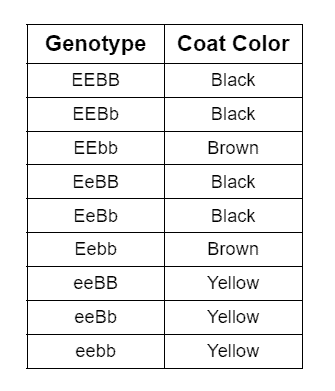Labradors come in a variety of colors! From classic black yellow and chocolate to rare shades like silver and red fox, there’s a color to suit everyone’s taste. We’ll explore everything regarding the 6 Labrador breed colors, from genetics to grooming tips! Labrador Retrievers come in 6 lab colors: black, yellow, chocolate, red fox, silver, and white.
Different Labrador Colors: An Overview
Black Labrador
Black Labs are one of the most popular Labrador colors. Their striking coat color is also the original color of Labrador Retrievers. A dominant gene causes this classic black Lab coat. This means that even if one parent has chocolate or yellow coat, some puppies may still be black.
Black Labradors have a unique protective coating on their fur, which helps them stay warm and dry. They are intelligent, loyal, friendly dogs and make great family pets.

Yellow Labs
Yellow Labradors are one of the most popular colors of Labrador Retrievers. They can range in shade from a light cream to a deep golden. Initially bred as retrieving dogs for hunters, they became beloved family pets due to their loyalty and gentle nature.
Two sets of genes determine their coat color. One determines if the dog will be yellow or not, and another determines the shade of yellow. Within a litter of yellow Labrador puppies, there can be variations in their coat colors. Many famous Labradors have been yellow, including Marley from the book “Marley & Me.”

Chocolate Lab
A recessive gene causes this distinct brown color. It can only be expressed if both parents pass on a copy of this gene to their offspring. Chocolate Labs have dark brown eyes and chocolate noses. They tend to have slightly shorter hair than black or yellow Labradors.
Chocolate labs are often described as friendly and energetic because of their love for children. They excel in hunting, swimming, obedience training, agility courses, and more. It is due to their high energy levels and strong athleticism.

Fox Red Labs
The fox red Labrador is a beautiful and rare color variation of the breed. A recessive gene causes this coloration. The coat color ranges from a deep red to a light golden shade, with variations. The fox red lab has all the traits that make this breed so beloved. Their unique coloring may set them apart visually, but their personalities are the same.

Silver Labs
Silver Labrador Retrievers have a beautiful grey coat that resembles stainless steel. While not recognized by the American Kennel Club as an official color, silver Labs are gaining popularity.
The silver coat color is caused by a dilution gene that affects black pigmentation. This gene makes their coats look like a lighter version of chocolate or charcoal labs. However, some worry about potential health issues like Color Dilution, Alopecia, or patchy fur. The rarity spikes up the prices due to demand.

White Labrador
White Labs possess a solid white coat due to their genetics. They may have colored pigment around their eyes or nose. The American Kennel Club does not recognize white Labs, but they still make great pets. White Labs are prone to deafness. They require the same grooming care and exercise as other Lab colors. Their coats should be brushed regularly to prevent matting.

Rare Labrador Colors And Their Characteristics
Labrador Retrievers are known for their classic black, chocolate, and yellow coats. However, there are also rare colors that can make them stand out. From the red fox to the silver Lab, these unique coat colors come with characteristics that make each dog special.
Can Labradors Be Different Colors Than Their Parents?
Labradors can have different coat colors than their parents due to genetics. Each puppy inherits one color gene from each parent, and the combination determines the puppy’s coat color.
A Labrador with black parents can have a yellow or chocolate color labrador coat. It happens when they inherit the recessive gene for those colors from both parents. These unique colors get passed down genetically or occur spontaneously due to mutations.
Which Is The Rarest Color?
The Silver Labrador is the rarest. This occurs due to a recessive gene that dilutes the pigment of their coat, resulting in an elegant silver hue.
Which Color Is Considered The Best?
There is no objective answer to which color is considered the best. It depends on what the owner is looking for in a dog. Black and yellow Labs are often more popular compared to chocolate labs. They are usually seen as the quintessential Labrador retriever. Yellow Labs tend to be friendlier and make better family pets. Each Lab color has its unique qualities that can appeal to different owners.
Which Lab Color Is The Calmest?
Labradors are known for their friendly and outgoing personalities. There is no scientific evidence to support this claim. However, black labs are said to be calmer.
lab coat color genetics
Labrador Retriever coat color is determined by genetics. Black is a dominant gene, while chocolate and yellow are recessive.
Understanding The Basics Of Color Genetics
Genetics can be complex, but understanding the basics can help you choose a dog. The three primary coat colors – black, chocolate, and yellow – are established by two genes: B and E.
Labradors with BB or Bb genes produce black coats, while bb produces chocolate puppies. The second gene determines the level of pigmentation in the coat. EE yields a yellow Lab, while Ee produces either a black or chocolate labrador with some white markings.
To make a chocolate Lab, both parents must carry at least one copy of the recessive “b” gene. When breeding two yellow Labs together, there is no guarantee that all puppies will be yellow. Silver Labs result from pigment dilution caused by breeding dogs who carry dilute alleles dd.
Why Black Is A Dominant Lab Color?
Black is the most common color for Labrador Retrievers. It is a dominant gene in their genetic makeup. This means that if both parents carry the black gene, their offspring will have a black coat. Black Labs are sought after for hunting and service due to their high energy levels.
Chocolate and yellow require two copies of the recessive genes to produce them. If one parent carries the dominant black gene, then there’s a chance their pups might still have black coats. This makes encountering a litter with at least some black-coated puppies likelier than any other color combination.
How Is A Chocolate Labradors Made?
Chocolate labs are produced when parents carry at least one copy of the recessive “chocolate” gene in their DNA. If two black Labradors have a chocolate gene mate, some of their offspring will be born with the chocolate-colored coat.
However, if only one parent carries the chocolate gene and mates with another dog without this genetic marker, none inherits the beautiful chocolate labrador coat.

Where Do The Yellow Lab Come From?
Yellow Lab, also known as Golden Labradors, are among the three most common Labrador Retriever colors. They originate from a recessive gene that dilutes the black coat color to create variations of cream and yellow lab color spectrum.
The gene responsible for yellow lab coats is called “ee.” It must be present on both sides of the pup’s lineage for the color to appear.
How Yellow Overrides Black And Chocolate?
While black and chocolate coats dominate, yellow coats result from two recessive genes. If a Lab inherits even one dominant black or chocolate gene, the resulting coat will be black or chocolate instead of yellow. Two yellow Labs can still carry black and chocolate genes in their DNA despite having a yellow coat. Hence, breeding two yellow Labs together can produce puppies with all three colors.
Nine Different Possible Labrador Genotypes
Labrador Retriever coat color is determined by genetics. Each dog has two copies of the genes that determine its coat color. There are nine different possible genotypes for Labradors.

- Black Labs can have either two dominant B alleles (BB), one dominant and one recessive B allele (Bb), or two recessive b alleles (bb).
- Chocolate Labs must have two recessive b alleles to express this color (bb).
- Yellow Labs can have either two dominant E alleles (EE) or one dominant and one recessive E allele (Ee), producing yellow puppies.
There are variations, like silver and charcoal. Charcoal labs come from breeding black Labrador retrievers carrying rare genetic traits that affect pigmentation. It creates a shade of deep brown.
Predicting Labrador Retriever Colors in Puppies
Knowing the puppies’ genotype makes it easier to predict the labrador color. Predictions are straightforward when both parents owe their appearance to b or e ( recessive genes ). A black lab can throw black, yellow, or brown puppies.
Mating Two Yellow labs
Two yellow labrador retrievers will never produce a black or brown puppy. Expect all offspring to be yellow labrador retrievers. They don’t possess the big E gene required for the masking effect switching.
Mating Two Chocolate labs
The absence of the big E gene in two chocolate labrador retrievers mixing prevents black puppies. However, yellow labs are possible if each parent has little e gene.

Four Ways to Be Black
There are four possible black genotypes. Find puppies produced below with each combination.Only if both parents have little e genes, yellow labs are possible. If one parent carries the little e, it will result in black pups. However, half will possess yellow genes leading to color skipping a generation.

Mating a Yellow Lab with Chocolate Lab
This mixing explains the complexity and unexpectedness of labrador colors. Depending on the parent genotype, there are six possibilities.
- Yellow, black, and chocolate puppies
- Black and chocolate puppies
- Yellow and black puppies
- All chocolate puppies
- All black puppies
- Yellow and chocolate puppies
Understand it better with the below chart.

Black Labs Crossed with Yellow Labradors
Mating a black and yellow labrador retriever offers numerous possibilities. There are four ways to be black and three to be yellow. Know your sire and dam’s genes for adequate expectations.

Black Labradors Crossed with Chocolate Labradors
While there are four ways to be black, chocolate labs have two genotypes. So, there are eight different possibilities.

How Labrador Colors Skip Generations
Chocolate labrador retrievers have grown in popularity. Black labs dominated this popular dog breed and kept the chocolate lab hidden. If the Bb gene is mated with the BB gene, generations of black labs can produce black puppies.

The b gene passes down for several generations without being expressive. Only two black labs with little b genes produce chocolate labs.

Only one-quarter of their puppies are chocolate-colored labs. A labrador with Bb genes produces only black puppies when it passes the B genes. Some labrador retrievers are neither brown nor black.
Grooming And Care For Labrador Retrievers
Proper grooming and care for Labrador Retrievers are essential for their overall health and happiness. These tips will help keep your Lab in shape, from coat maintenance to diet and exercise.
Coat Maintenance And Grooming Tips
Their coat is relatively easy to maintain. Brushing them regularly helps prevent tangling and mating.
- Regular bathing is unnecessary unless they get filthy or have skin conditions.
- Frequent nail trimming help protect both you and your dog from scratches.
- Pay special attention to the ears of Labs as they are prone to infection due to moisture buildup. Clean their ears weekly with a gentle ear cleaner.
- Check for any signs of redness or irritation in their eyes and clean them with a damp cloth if needed.
You can take the help of professional groomers’ help, invest in quality grooming tools, or do it yourself at home.
Diet And Exercise For Optimal Health
Feeding them a balanced and nutritious diet is vital. Avoid giving them table scraps. Instead, stick with high-quality dog food recommended by veterinarians. These dogs have high energy levels, so provide them with plenty of opportunities to burn off energy. Regular exercise also helps prevent destructive behaviors like chewing on furniture or digging holes in the yard.
Do Different Colored Labs Behave Differently?
There is no significant correlation between behavior and lab coat colors.
Debunking Color-based Behavior Stereotypes
Lab coat colors have long been associated with specific personality traits, but these stereotypes are inaccurate. While a yellow Lab is often considered the laziest breed, there is no evidence. On the other hand, Black Labs are believed to be better hunters.
A Lab’s behavior is determined by genetics and training rather than its coat color. Owners should focus on socializing and training their pups from an early age. Choose a Labrador based on temperament and energy level instead of relying on outdated color-based stereotypes.
Examining The Impact Of Genetics And Training
Genetics is essential in physical attributes such as size, energy levels, and health issues. Consistency and positive reinforcement are key. Good breeding practices help reduce the likelihood of inherited health problems such as hip dysplasia or eye disease.
Responsible breeders conduct genetic testing on breeding dogs before mating. It ensures healthy puppies with desirable traits. As prospective Lab owners, consider the breeder’s reputation before getting a pup.
Choosing The Right Labrador Color For You
When selecting the perfect Lab color, consider your lifestyle and personality traits.
Factors To Consider When Choosing A Lab Color
- Firstly, assess your lifestyle and living situation. A lighter-colored coat, such as yellow, is suitable if you live in a hot climate.
- Secondly, a darker coat like black or chocolate may suit you better if you live in a colder climate or enjoy hunting activities.
- Third, consider your personal preferences.
Matching Personality Traits With Lab Colors
Labrador Retrievers come in six major colors. According to experts, coat color has little to no impact on a Lab’s temperament. Matching a dog’s personality traits with your lifestyle and needs is essential.
For example, a black or chocolate-colored Lab may be best if you’re active and enjoy outdoor activities such as hiking or running. But, if you live in an apartment or prefer relaxed activities like snuggling on the couch and watching TV, a yellow Labrador is best.
FAQs
Can two black labs have yellow or chocolate puppies?
Two black labrador retrievers can indeed have a yellow or chocolate lab. It entirely depends on their genotype. The black lab has four different genotypes, which refers to the genetic code the dog carries.
Do different color labs have different personalities?
No, there is no scientific evidence to suggest that different color Labradors have different personalities. Coat color is determined by genetics, but various factors, including genetics, breeding, environment, and training influence personality.
Which color of Labrador is best?
The best color of Labrador is the one that you love the most! All Labrador Retrievers are known for being friendly, outgoing, and intelligent dogs. They make great family pets and working dogs alike
Is It Possible to Get All Three Colors from Two Black Dogs?
Yes, getting all three colors from two black dogs is possible. It happens when both dog parents have the EeBb genotype. A little e and a little b lead to it.
What are unusual labrador retriever colors?
Other lab colors get diluted by the dd genotype. It results in an unusual charcoal coat color in a black dog and pale champagne color in yellow.
What color labrador retrievers live the longest?
Dogs with yellow and black coats live 10 % longer than their counterparts. All labrador retrievers have an average lifespan of 12 years. However, it is 10.7 for chocolate labs.
Author Profile
- Site Owner And Dog Lover
-
Aritra, the founder of Labradorandyou.com, is a lifelong dog lover whose passion ignited for Labradors for their loyalty and intelligence. With extensive research and personal experiences, Aritra has become a Labrador expert, offering a rich resource on the breed. Labradorandyou.com provides reliable, timely, and evidence-based information, including Labrador-specific product reviews, training techniques, and care tips.
Labradorandyou.com was born out of Aritra's passion and his desire to share his profound knowledge about the breed. The site serves as a comprehensive resource, offering a wealth of up-to-date information for Labrador owners and enthusiasts alike
Also by the author
 Lab-TypesNovember 17, 2023Old Dog Seizures: Causes, Symptoms, and Treatment Options
Lab-TypesNovember 17, 2023Old Dog Seizures: Causes, Symptoms, and Treatment Options Lab-TypesNovember 17, 2023Why Is My Dogs Poop Yellow? 8 Reasons & Solutions
Lab-TypesNovember 17, 2023Why Is My Dogs Poop Yellow? 8 Reasons & Solutions ReviewsNovember 17, 2023The Only Hill’s Science Diet Review You Need To Read
ReviewsNovember 17, 2023The Only Hill’s Science Diet Review You Need To Read Lab-TypesNovember 17, 2023How To Adopt An Emotional Support Dog?
Lab-TypesNovember 17, 2023How To Adopt An Emotional Support Dog?





